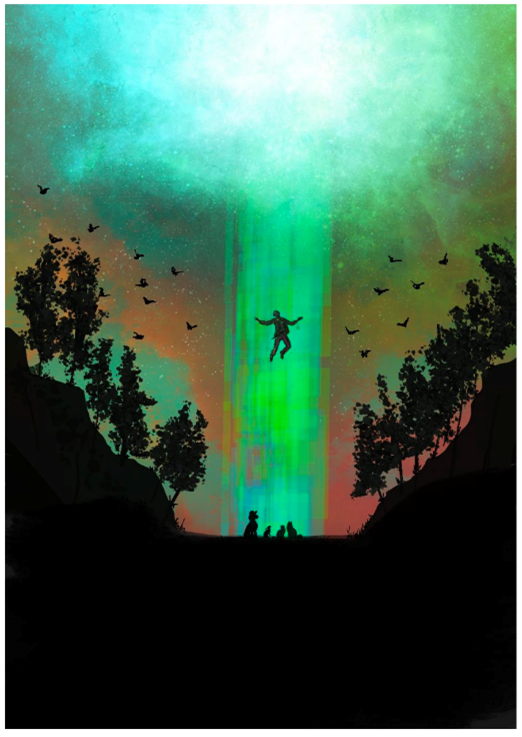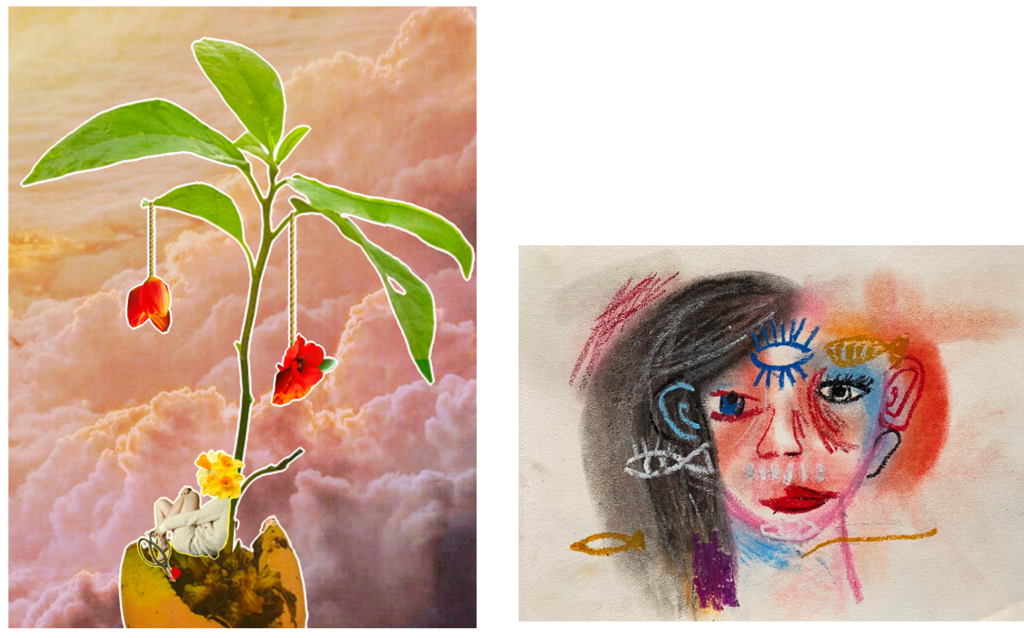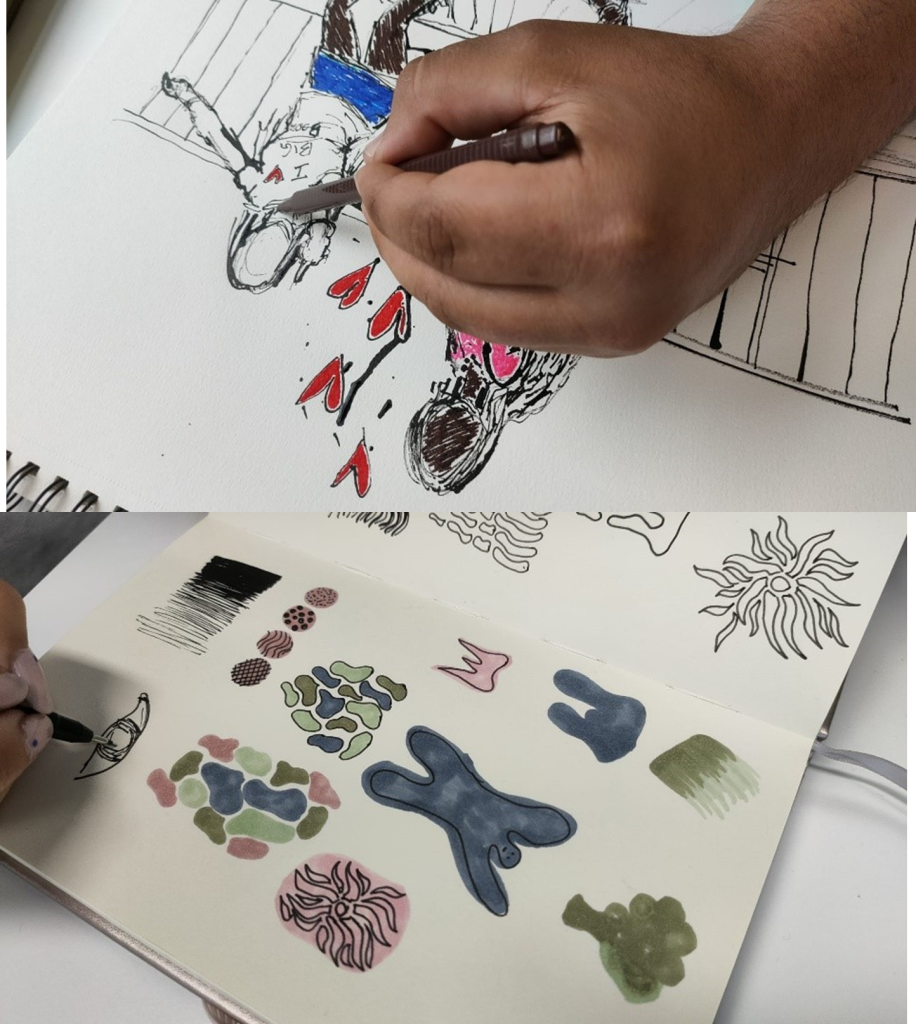Always wanted to explore your creative talents? In this minor we will dive right in, exploring a plethora of creative expressions by analyzing, assessing, and creating. You can expect field trips, workshops, guest lecturers, documentaries and films, discussions, creative outlets, pitches and presentations.


(Student work 2023/2024, names known by coordinators)
Admission
There are no specific entry requirements for this course. The minor does not require an internship or workplace.
No artistic talent is required; however, you should be excited to creatively explore analog and digital forms of expression.
The Examination Board determines which minors do not have a higher professional education level and/or have an unacceptable overlap with the compulsory curriculum of your own study programme. Check at the page Not allowed minor courses under your institute which minors are not allowed. This page will be updated from 29 February 2024 for the 2024-2025 minor offer.
Content
A picture says more than a thousand words, we all know that. Today’s (creative) industries expect higher attention to visual presentation, (for example, a simple cv is not a word-document anymore, but a stylized product, with a carefully chosen color-palette and fonts). Not everyone can produce, choose, or assess a good and impactful design, though, and through this minor, students can get closer to this. With this minor, students can create more impactful designs for their concepts, pitches, presentations, and other professional products. They will be better prepared with more creative and design skills for work placement and applied research graduation projects, in their prototyping phase. Next to creation, they will be stronger in their assessment and advice on creative work. – On top of this, students will also have access to new forms of expression – applied and free-form – through which they can explore their own creativity.
We want to connect professional practice through real briefs, invite guest lecturers, take field trips to creative workplaces and art-oriented places (including museums, art-shows, shops, workshops). While attendance is encouraged, it is not mandatory.

(Right: Student work 2023/2024, name known by coordinators)
Learning Objectives
Each block will have three courses: one theory, one creative practice skills and one applied visual design.
Theory courses take the form of lectures, videos, and off-site excursions, followed by flipped-classroom debates, discussions and additional research into the role visual culture and design play in academic and professional environments.
Creative practice skills are very hands-on, practical activity-driven courses. Creative expression and presentation skills will fuel an iterative approach to generating concepts and communicating these effectively. Students are encouraged to explore alternative and often unexpected forms of expression in finding their own creative voices via various pitching, presentation, and feedback formats.
Applied visual design courses require self-directed learning as class preparation, demonstrations in class and guided application to professional products (static and video) in workshop situations. While no prior design or art skills are required, these courses will offer fundamental training in image making – both analog and digital.
The core competences assessed in this minor will include Creative Thinking, Commercial Excellence, Human-centered Approach, Applied Research and Lifelong Learning.
Learning objectives include:
- Students can critically analyze art and design work of past and present, consider the cultural context and engage in argumentative discussion/debate.
- Students can recognize value and worth in a creative context, show an understanding of financial literacy and manage creative processes.
- Students can demonstrate varied concept generation in a design process, explore the solution space using multiple ideation techniques, and recognize challenges therein.
- Students can iterate on ideas formed in the idea generation process to offset disruption and understand how to be more effective in ideating under different constraints.
- Students can demonstrate the application of different art tools and techniques, create a variety of static and moving creative work, document their creative process and evaluate their progress.
- Students can effectively communicate their creative ideas, particularly analyze their own work and that of others, and convince stakeholders of the contents and value of their creative pitch.
Courses
CREATIVE CULTURE (5 ECT)
The Who, What and Why: Creatives define culture. Past, present, and future. As such, understanding the history and the culture behind creativity and design will give students a better appreciation of the visual world around them. The course invites them to train their visual acuity then emphasize and create added depth and (historic/cultural) value to their concepts/ideas/designs.
PICTURE BOOK (5 ECT)
Diving into the world of static art: This course explores skills, tools and techniques employed in making static visual marks. Critical decisions regarding medium, format, style and tools will be made to align with effective communication to meet briefing requirements.
IDEA ENGINE (5 ECT)
Generate, ideate, and conceptualize: Skill training in observation, association, combination, and correlation will take place as regular energizers to drive creativity and motivate the inspiration/perspiration workflow. Multiple techniques, from sketching to collage, modelling and more will all be practiced via application to user cases with an emphasis on innovative conceptual thinking.
WHAT’S IT WORTH (5 ECT)
The value of creativity: Viewed from a creative perspective, but also from a business perspective. How does a creative make a living? In this course we investigate financial literacy and commercial excellence, diving into worth versus value (time, money, man-hours), funding, budgeting, and management of the creative process. We also explore the need for flexibility and the ability to embrace disruption and complexity within the creative market.
A NIGHT AT THE MOVIES (5 ECT)
Exploring the world of the moving image: On top of skills, tools, and techniques in creating moving images, students will engage and analyze a variety of film/video formats. Discussions surrounding style, content and purpose will be applied to creative briefs for the development of moving picture products.
PARLEZ-VOUS DESIGN? (5 ECT)
Driving the idea home: You will acquire skills in pitching and presentation that will be conveyed via real-world scenarios. These include dealing with customers, giving and receiving feedback, the importance of storytelling, personal branding and collaboration. During this course you will have the exciting opportunity to design and construct your very own Crowdfunding Campaign and landing page, to promote your own idea or project. This page will serve as the platform where you will skillfully persuade the audience to support your innovative ideas and ventures.

Assessment
- Courses will combine short sprints and workshops allowing for embedded feedback moments culminating in a summative presentation, pitch, creative product or report.
- Individual assignments will be submitted for each course, even if workshops may be conducted in groups.
Literature
- Real Artists Don’t Starve, by Jeff Goins
- Steal Like an Artist, by Austin Kleon
- Hello World: Where Design Meets Life, by Alice Rawsthorn
- Feck Perfuction: Dangerous Ideas on the Business of Life, by James Victore
- Additional materials will be provided as online links or PDF.
Schedule
No fixed teaching/internship days provided as yet.
With the exception of the first teaching period of the academic year (starting September), the lesson and test schedules are always posted on Mijn Rooster four weeks before the start of each teaching period. The schedule for the first teaching period of the academic year can be found on the site three weeks before the start. The most up-to-date schedule is always visible on Mijn Rooster.
At HU, full-time education may be scheduled between 08:30 and 19:00.
Additional costs
Because field trips will be an essential part of the course, keep an eye on additional costs.